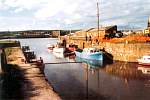Chapter 2: The impact of the sea
2.1 Tides (2)

| European Coasts - An Introductory Survey Chapter 2: The impact of the sea 2.1 Tides (2) |
|
 |
 |
 |
| Fig 34: The harbour of Llanelli at low water, South Wales, UK | Fig 35: The harbour of Llanelli at high water, South Wales, UK | Fig 36: Lock of IJmuiden, the Netherlands |
A very spectacular consequence of the tide is the so-called tidal bore (see Fig. 33). Due to the physically limited speed of the tidal wave in shallow rivers, a hydraulic jump migrates up river.
One consequence of large tidal ranges is that many harbours are inaccessible during low water (see Fig. 34). Harbours with a large tidal influence can be closed with locks (see Fig. 36). This ensures a constant water level in the harbour basin, the elimination of tidal currents in the basin and an improvement in accessibility during low water. Yet, ship passage through the locks is time consuming.
Many harbour approaches are rather complicated. Often sailing is restricted to the tidal gullies, since large areas are too shallow for safe navigation (see Fig. 37). If the tidal gullies meander unpredictably through the coastal zone, the buoys that mark the channels are constantly being relocated by the local port or waterway authorities.
previous page table of contents next page
| This page is from the book "European Coasts", produced in the framework of the Erasmus project under EC contract ICP 92-G-2013 and placed on the Internet in the framework of the PIANC-MarCom initiative on Education. |